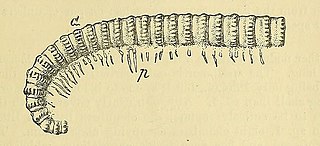 W
WPill millipedes are any members of two living orders of millipedes, often grouped together into a single superorder, Oniscomorpha. The name Oniscomorpha refers to the millipedes' resemblance to certain woodlice (Oniscidea), also called pillbugs or "roly-polies". However, millipedes and woodlice are not closely related ; rather, this is a case of convergent evolution.
 W
WAmynilyspes is an extinct genus of pill millipedes characterized by fourteen tergites, large eyes, and prominent spines. Individuals measure up to 30 mm (1.2 in) in length.
 W
WArchipolypoda is an extinct group of millipedes known from fossils in Europe and North America and containing the earliest known land animals. The Archipolypoda was erected by Scudder (1882) but redefined in 2005 with the description of several new species from Scotland. Distinguishing characteristics include relatively large eyes with densely packed ocelli, and modified leg pairs on the 8th body ring. Some species had prominent spines while others had a flattened appearance.
 W
WArthropleura is a genus of extinct millipede arthropods that lived in what is now northeastern North America and Scotland around 345 to 295 million years ago, from the Viséan stage of the lower Carboniferous Period to the Asselian stage of the lower Permian Period. The larger species of the genus are the largest known land invertebrates of all time, and would have had few, if any, predators.
 W
WArthropleuridea is an extinct subclass of myriapod arthropods that flourished during the Carboniferous period, having first arose during the Silurian, and perishing due to climate change just before the Early Permian. Members are characterized by possessing diplosegement paranotal tergal lobes separated from the body axis by a suture, and by sclerotized plates buttressing the leg insertions. Despite their unique features, recent phylogenetic research suggests Arthropleuridea be included among millipedes in the class Diplopoda. The subclass contains three recognized orders, each with a single genus.
 W
WEuphoberiidae is an extinct family of archipolypodan millipedes known from the Upper Pennsylvanian of Europe and North America. The family includes relatively large millipedes measuring up to 30 cm (12 in) long bearing distinctive spines and were the dominant millipedes of the Pennsylvanian.
 W
WLatzelia is an extinct genus of scutigeromorph centipedes, and the type and only genus of the family Latzeliidae. It existed during the Carboniferous in what is now Illinois. It was described by Samuel Hubbard Scudder in 1890, and the type species, and only known species, is Latzelia primordialis. The genus name honors Austrian zoologist Robert Latzel.
 W
WMyriacantherpestes is an extinct genus of spiny millipedes from the Pennsylvanian subperiod of the Carboniferous period, known from fossils in Europe and North America.
 W
WNyranius is a genus of fossil millipedes from the Upper Carboniferous (Westphalian) of Europe, containing the species N. costulatus and N. tabulatus. Specimens reach up to 10mm in width, and are covered in fine grooves, similar to other members of the extinct Xyloiuloidea.
 W
WPalaeosoma is an extinct genus of archipolypodan millipedes from the upper Carboniferous of England and Poland. Individuals grew to nearly 20 cm (7.9 in) long and possessed defensive glands (ozopores) located on small raised nodes on the outer edges of the upper surface of each body segment. Species of Palaeosoma were once considered members of the family Euphoberiidae, which contains species with prominent spines, but are now classified in their own family (Paleosomatidae) and own order (Palaeosomatida), as they lack spines and have a combination of features not seen in other Paleozoic millipedes.
 W
WPleurojulidae is an extinct family of millipedes known from the Westphalian stage of the upper Carboniferous that are distinct enough to be placed in their own order, Pleurojulida. Fossil pleurojulids up to 10 centimeters long are known from Europe and the United States.
 W
WXyloiuloidea is an extinct superfamily of millipedes that existed from the Lower Devonian through the Upper Pennsylvanian period in Europe and North America.
 W
WXyloiulus is an extinct genus of millipede that lived during the Late Carboniferous which grew up to 2.25 inches (5.7 cm) in length. Fossils of the animal have been found in North America and Europe. The fossils are typically found in Sigillarian stumps.
 W
WZosterogrammidae is an extinct family of millipedes containing three genera, each with a single species. Fossils are known from the Czech Republic, Scotland, and the USA. Zosterogrammidae constitutes the sole family of the order Zosterogrammida.
 W
W W
W